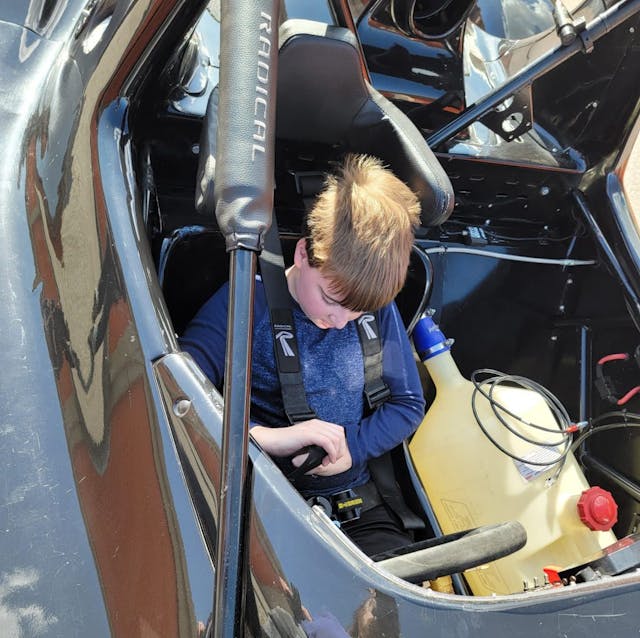Avoidable Contact #148: Trying to be about it, not just talk about it

My son was on the phone with his best friend from school. “OK, you have Forza right? And in Forza they have the Radical SR8, which is one of the fastest cars in the game? Well, Dad’s new car is that car … but it’s better than that car—the car in the game is the old one, this one is even faster. The one in the game is the trash version, the SR8 RX. Dad has the new one, the RSX Generation 3.” There was a pause in his rapid-fire delivery. Then, in less animated fashion, “No, I think he’ll probably be OK.”
“Wish I shared your confidence,” I said, hitting the X button on my $99 XBox steering wheel to “rewind” my trash, slow digital version of the Radical SR8 out of the wall at the top of Watkins Glen’s Esses. Drivetrain damage, the screen advised. Cosmetic damage.
“That we occasionally violate our own stated moral code … does not imply that we are insincere in espousing that code.” I tend to share the view of hypocrisy espoused by some characters in Neal Stephenson’s The Diamond Age, namely: Much of what we call “hypocrisy” is just trying to be good, and failing along the way. I’m not talking about the kind of deliberate, preplanned hypocrisy you see in the kind of people who, for example, spend several years babbling about “eat the rich” and “class warfare” on social media, only to become slum lords or day traders the minute they fall backwards into a few bucks. Nor am I referring to people who abuse a position of moral trust in order to take advantage of others. Those are different, and far more reprehensible, ways to behave.
I’m thinking more of the kind of hypocrisy that happens when I tell my younger brother he should not buy a third Genesis sedan and instead invest his nontrivial income in conservative fashion for his children’s future, only for him to say, “Didn’t you just blow, like, a major chunk of your son’s future on a race car with a $37,500 engine-out refresh, required every 40 running hours, those running hours including the 30 minutes you need to spend warming it up before each track session?”
“Well, I see your point, but … I’m giving him my Radical PR6, you know.”
“Will MIT take a Radical PR6 as a partial tuition payment?”
“Maybe if we can find a way to turn it into Dogecoin.” So yeah, there’s a bit of hypocrisy going on here. I’m not a wealthy man. The Radical SR8 is a wealthy man’s car. It was meant to be a $165,000 toy for investment bankers to use while playing race car–driver on selected weekends, in the company of stunning professional models who wear astounding bright blue outfits celebrating Blue Marble Vodka. When I show up for my first “Blue Marble Platinum” race, I will not just be the poorest person on the grid; I stand a good chance of being the poorest person in the zip code. Four years ago, when I ran Pirelli World Challenge, my team was the only one with an open car-hauler. The competition arrived by private plane and slept in gorgeous motorcoaches by Newell and Prevost; I drove overnight to the track so I could save a night’s worth of rack rates at the Fairfield Inn.
Let the record show we didn’t finish close to last.

My father hasn’t spoken to me since I bought the SR8 from my long-time friends at Radical Canada. He probably thinks I’m wasting a plurality of my financial resources on something that could be destroyed in a moment’s worth of carelessness on my part or the part of the investment banker next to me. No doubt he thinks it’s extremely hypocritical for me to lecture my son about “planning for tomorrow” and “taking the long view” only to splurge on something this self-indulgent in the twilight of my peak earning years. He’s right. I’m a hypocrite. But I’m trying to avoid becoming a different sort of hypocrite.
Let me explain.

I’ve been a racer of one kind or another since I was 14 years old. First bikes, then cars, then both at the same time. It’s shaped who I am, for better or worse, and so strongly that it has spilled over the lip of my psyche’s narrow cup into that of my boy, who is also a racer on two and four wheels. I’m not truly happy unless I’m trying to beat someone else at something. Doesn’t matter what. I am the sort of deeply unpleasant person who will throw a temper tantrum because I failed to beat the high score on a random Galaga arcade machine. Two weeks ago, my son and I drove go-karts in Pigeon Forge, Tennessee, on karts that struggled to reach 10 mph uphill, and I put him in the wall rather than lose. When it’s too cold outside to race, I will trash-talk children on Call Of Duty. (Look for me! My gamer tag is JacoOnlyNeeded4.)
It’s not just racing. As a writer, I’m obsessed with every little nuance of grammar and expression, always trying to outdo my contemporaries. The rapper Pusha T recently said that he was:
Already aligned with the greats, and on that same note
The only ones I chase are two ghosts
Pusha meant Biggie and Tupac; when I read that I think “Gordon Baxter and LJK Setright,” the diametrically opposed brace of Muses who set me on the path before I turned ten. If you want to be “aligned with the greats,” of course, you have to take risks. It’s no trouble to have a highly gratifying career as an autowriter. All you have to do is write whatever you’re told to write, whether by the automakers or your peers or your bosses. If you do that, you can have a free $100,000 car in your driveway year round. You can travel to the Miami F1 race on a car company’s dime and sit trackside while people fetch your drinks. If you’re appropriately subservient you might even find yourself working a cushy PR or industry-adjacent job after a while. You won’t have a soul left to barter with, and nobody will ever remember a single thing you’ve written, but neither will you know a moment’s worth of suffering.
I’m here to suffer. I’m here to ruffle feathers, to ask awkward questions. When I challenge authority, it doesn’t come in the form of lobbing a few feckless social bombs at a president or a distant CEO. That’s like counting yourself courageous because you’ll scream at the sky when no one is looking. Instead, I’m here to directly confront the people who want to take our beloved mutual hobby away from us, who want to restrict you to a Red Barchetta’s worth of communion with a cherished car. Some of you get really angry when I point out the fundamental flaws in the “EV future” or the “autonomous future.” I’m sorry you’re angry. If you’re a Hagerty member, or a potential one, I work for you—but the most honest, the least hypocritical, way to work for you is to tell you the truth wherever I can find it, not to soothe your feelings.
There’s a phrase out there: “Be about it, don’t talk about it.” I know a lot of people around my age, in situations similar to mine, who talk about wanting to have their dream car, but in the end they always do the sensible thing, the prudent thing. They say that their wives (or husbands) won’t let them have their “game over” or “destination” vehicle—but I get the sense that they never asked. Or they’re club racers who say, “Someday I’ll get a (insert dream here) but now isn’t the time.”

I’m fifty years old. If the time isn’t now, I have no idea when it could be. I won’t see any better next year, my reflexes won’t be faster, I won’t be in less pain climbing over carbon-fiber bodywork. From the moment Radical introduced the SR8, with its absurd specifications:
- 1500 pounds!
- Upside-down downforce!
- 440 horsepower at 10,500 rpm from an entirely hand-built 2.7-liter V-8 with Hayabusa heads!
- 6:48.28 on the Burgerkingring—on the sloppy street tires of 2009!
- Near-as-darn-it LMP3 pace in a car with no roof!
I knew I wanted one. The SR8 RSX, which took all of the above and added slinky bodywork, was even better. The Gen 3 SR8 is better still, and that’s what I have.
The Radical SR10, of course, is even better than the SR8, and capable of beating it on most tracks. The investment bankers are shedding their SR8s for SR10s, which is how I was able to get my Gen3 SR8 for less than $165,000. I don’t mind being on the end of the high-net-worth human centipede. For some reason, I don’t want an SR10. The powerplant might be a little more powerful and a lot more sensible, being basically the Focus RS four-banger puffed-up to 380 lb-ft of torque, but it’s prosaic where I want bespoke. Nobody ever dreams of racing a four-cylinder car with a 6500 rpm redline, no matter how powerful it might be.
Buying and running the SR8 means I’ll probably never again have a nice street car. Certainly won’t have a Genesis G90 5.0, which is my dream sedan. It’s okay. A long time ago, Ross Bentley told me, “If you’re really serious about racing, sell your street car and spend the money on racing.” I’m not quite doing that—still have my Accord!—but neither am I swanning around in the sort of vehicle commonly driven by company directors in late-middle age such as myself. I’m thinking about getting two bumper stickers for my Honda, which just had its 100K timing belt service:
DON’T LAUGH, IT’S PAID FOR
and
MY OTHER CAR IS A RADICAL SR8
I’m here to be a racer. To run the fastest machinery I can(not) afford, as close to the limit as I can manage. If I crash the SR8, I’ll no doubt regret my choice, doubly so since I won’t be able to replace it. But this is life, not the Life board game that I played as a child. You don’t add up all your investments at the end and declare a winner. What happens when you die is up to a greater authority than that, whether it’s the Lord of my altar-boy youth or the skeletal hand of undeniable entropy. I will go to either one with a full heart. I did my best. I was a little hypocritical at times, usually through an excess of passion. And when the chips were down, I didn’t choose to talk about it. I chose to be about it.
When you’re out there on the racetrack, and you see me in your mirrors, please put your hand out to the left of your car, nice and far so I can see it. I’ll be out of your way and gone in just a few seconds. Or so I hope. There’s no rewind button out there, you know.

